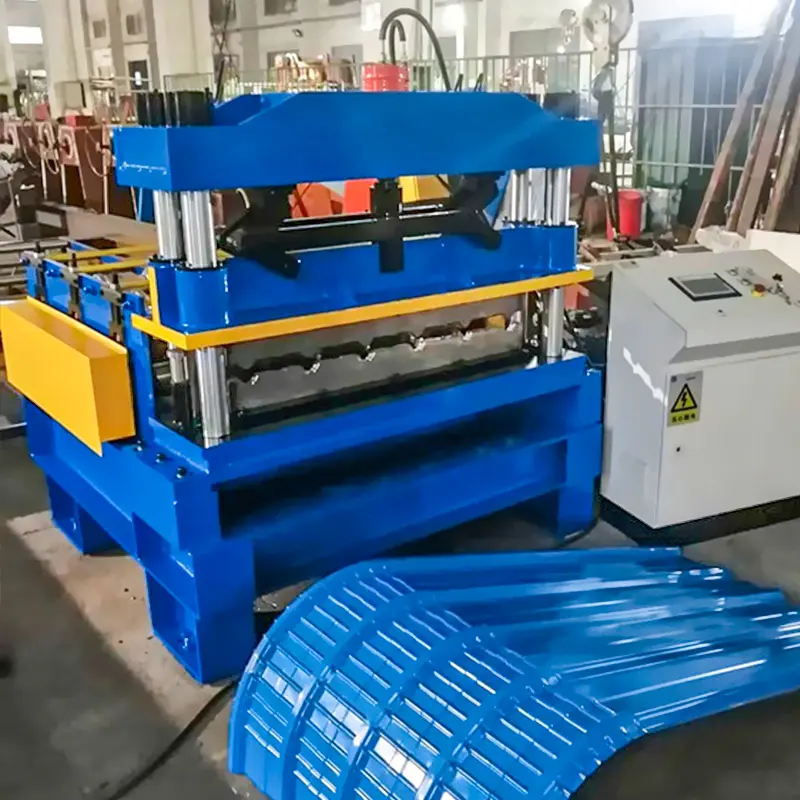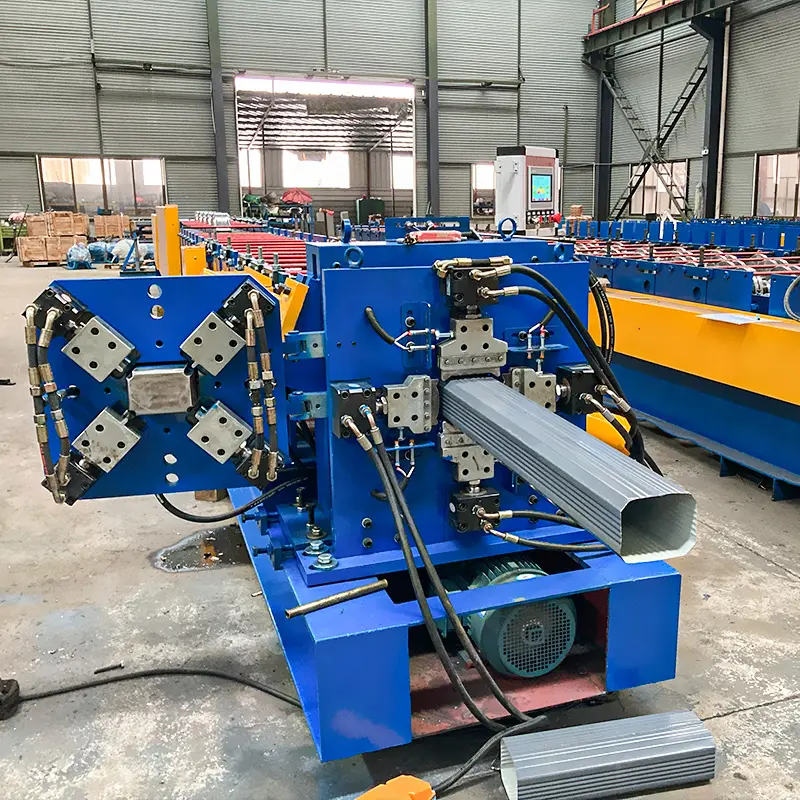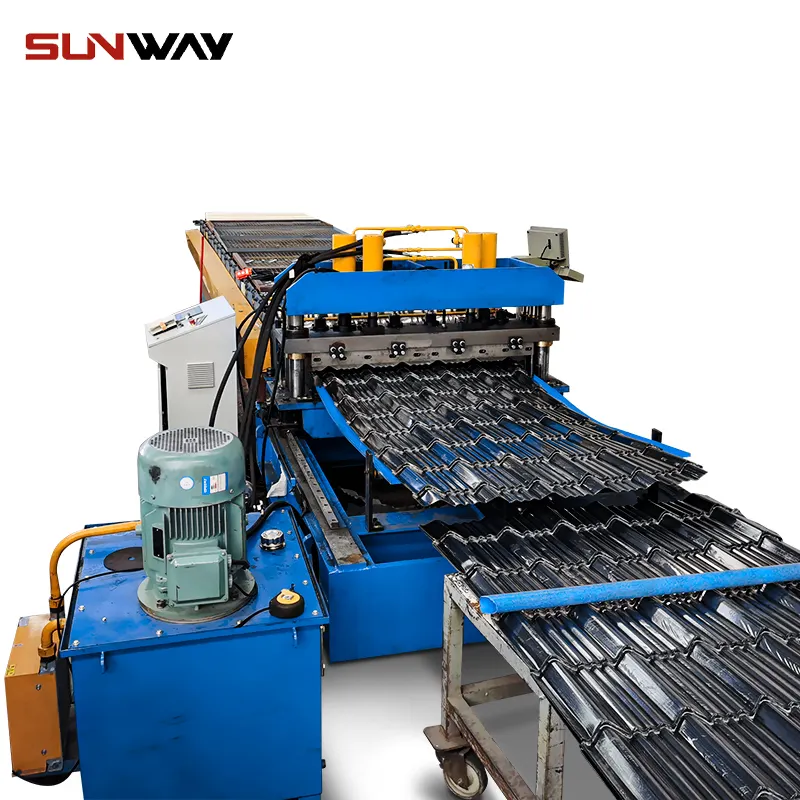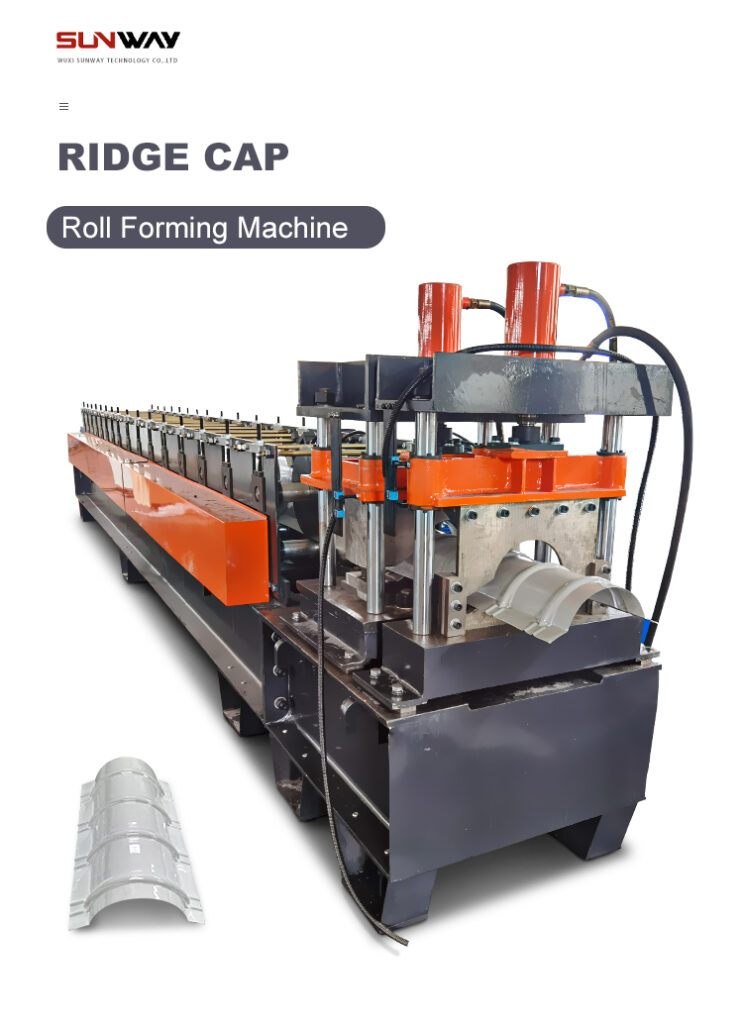परिचय
The सी स्टड रोल फॉर्मिंग मशीन एक विशेष उपकरण है जो सी-आकार के धातु स्टड्स तैयार करने के लिए डिज़ाइन किया गया है, जिनका उपयोग दीवारों, छतों और विभाजनों के निर्माण में आमतौर पर किया जाता है। यह लेख सी स्टड रोल फॉर्मिंग मशीनों की जटिलताओं पर गहराई से प्रकाश डालता है, जिसमें उनके कार्य सिद्धांत, लाभ, प्रकार, प्रमुख घटक और अनुप्रयोग शामिल हैं।
सी स्टड रोल फॉर्मिंग मशीन के लाभ
सी स्टड रोल फॉर्मिंग मशीनों के तकनीकी पहलुओं पर चर्चा करने से पहले, आइए समझें कि निर्माण उद्योग में इन्हें क्यों पसंद किया जाता है। इन मशीनों के उपयोग के लाभ निम्नलिखित हैं:
- उच्च उत्पादन दक्षता: सी स्टड रोल फॉर्मिंग मशीनें कम समय में बड़ी संख्या में सी स्टड्स का उत्पादन कर सकती हैं, जिससे समग्र उत्पादन दक्षता में सुधार होता है।
- : Collect/output.: ये मशीनें सी स्टड्स के आयामों और गुणवत्ता में एकरूपता सुनिश्चित करती हैं, जिससे सामग्री की बर्बादी कम होती है और लागत की बचत होती है।
- Versatility: सी स्टड रोल फॉर्मिंग मशीनों को विभिन्न आकारों के सी स्टड्स बनाने के लिए समायोजित किया जा सकता है, जो इन्हें विभिन्न निर्माण अनुप्रयोगों के लिए उपयुक्त बनाता है।
- प्रभावी लागत: उच्च गति उत्पादन और कम सामग्री बर्बादी के साथ, सी स्टड रोल फॉर्मिंग मशीनें सी स्टड निर्माण के लिए एक किफायती समाधान प्रदान करती हैं।
- Automation: आधुनिक सी स्टड रोल फॉर्मिंग मशीनें उन्नत स्वचालन सुविधाओं से लैस होती हैं, जो मैनुअल श्रम की आवश्यकता को कम करती हैं और त्रुटियों की संभावना घटाती हैं।

सी स्टड रोल फॉर्मिंग मशीन कैसे कार्य करती है?
सी स्टड रोल फॉर्मिंग मशीन का कार्य सिद्धांत अत्यंत कुशल और चतुर है। इस प्रक्रिया को निम्नलिखित चरणों में विभाजित किया जा सकता है:
- सामग्री का अनकॉइलिंग: प्रक्रिया मशीन के डीकोइलर पर कच्ची सामग्री (आमतौर पर स्टील) की कॉइल लोड करने से शुरू होती है। डीकोइलर सामग्री को रोल फॉर्मिंग इकाई में खिलाता है।
- रोल बनाना: रोल फॉर्मिंग इकाई में एक श्रृंखला के रोलर्स और डाइज़ होते हैं जो सपाट धातु पट्टी को धीरे-धीरे वांछित सी-आकार के प्रोफाइल में आकार देते हैं।
- काटना: जैसे ही सी स्टड आवश्यक लंबाई तक पहुंचता है, कटिंग इकाई सक्रिय हो जाती है और स्टड को वांछित आकार में सटीक रूप से काट देती है।
- अतिरिक्त विशेषताओं का निर्माण: कुछ सी स्टड रोल फॉर्मिंग मशीनों में नॉकआउट्स या लिप्स जैसी विशेषताओं को बनाने के लिए अतिरिक्त स्टेशन होते हैं जो स्टड की कार्यक्षमता बढ़ाते हैं।
- ढेर लगाना: तैयार सी स्टड्स को स्टैक किया जाता है और पैकेजिंग या आगे प्रसंस्करण के लिए तैयार किया जाता है।
परिणामस्वरूप एक सतत और स्वचालित उत्पादन प्रक्रिया होती है जो उच्च गुणवत्ता वाले सी स्टड्स की निरंतर आपूर्ति सुनिश्चित करती है।
सी स्टड रोल फॉर्मिंग मशीनों के विभिन्न प्रकार
सी स्टड रोल फॉर्मिंग मशीनें विभिन्न उत्पादन आवश्यकताओं को पूरा करने के लिए विभिन्न कॉन्फ़िगरेशन में उपलब्ध होती हैं। मुख्य दो प्रकार निम्नलिखित हैं:
सिंगल-साइड सी स्टड रोल फॉर्मिंग मशीन
सिंगल-साइड सी स्टड रोल फॉर्मिंग मशीन एक तरफ से कार्य करती है, जो एक समय में एक सी स्टड प्रोफाइल बनाती है। यह छोटे पैमाने के उत्पादन और सरल डिज़ाइनों के लिए उपयुक्त है।
डबल-साइड सी स्टड रोल फॉर्मिंग मशीन
डबल-साइड सी स्टड रोल फॉर्मिंग मशीन में दोनों तरफ रोल फॉर्मिंग इकाइयां होती हैं, जो इसे एक साथ दो सी स्टड्स उत्पादित करने में सक्षम बनाती हैं। इससे उत्पादन क्षमता में उल्लेखनीय वृद्धि होती है और यह बड़े पैमाने के निर्माण के लिए आदर्श है।
सी स्टड रोल फॉर्मिंग मशीन के प्रमुख घटक
एक सामान्य सी स्टड रोल फॉर्मिंग मशीन में कुशल उत्पादन प्राप्त करने के लिए सामंजस्य में कार्य करने वाले कई प्रमुख घटक होते हैं:
डेकोइलर
डीकोइलर कच्ची सामग्री की कॉइल को धारण करता है और इसे रोल फॉर्मिंग इकाई में खिलाता है। यह उत्पादन के दौरान सामग्री की सतत आपूर्ति सुनिश्चित करता है।
रोल फॉर्मिंग इकाई
रोल फॉर्मिंग इकाई एक श्रृंखला के रोलर्स और डाइज़ का उपयोग करके सपाट धातु पट्टी को सी स्टड प्रोफाइल में आकार देती है।
कटिंग इकाई
कटिंग इकाई तैयार सी स्टड्स को वांछित लंबाई में सटीक रूप से काटती है।
नियंत्रण प्रणाली
नियंत्रण प्रणाली मशीन के सम्पूर्ण संचालन को नियंत्रित करती है, जो आसान समायोजन और निगरानी की अनुमति देती है।
Stacker
स्टैकर तैयार सी स्टड्स को एकत्रित करता है और आगे हैंडलिंग के लिए व्यवस्थित करता है।

सी स्टड रोल फॉर्मिंग मशीन चुनते समय विचार करने योग्य कारक
सी स्टड रोल फॉर्मिंग मशीन में निवेश करते समय, कई कारकों पर विचार किया जाना चाहिए:
उत्पादन गति
उत्पादन गति आपके आवश्यक उत्पादन और समयसीमाओं के अनुरूप होनी चाहिए।
सामग्री संगतता
सुनिश्चित करें कि मशीन सी स्टड उत्पादन के लिए आपके इच्छित विशिष्ट सामग्रियों को संभाल सके।
मशीन का आकार और लेआउट
अपनी सुविधा में उपलब्ध स्थान पर विचार करें और अपने लेआउट आवश्यकताओं के अनुरूप मशीन चुनें।
Automation Level
उच्च स्तर का स्वचालन अधिक दक्षता और कम श्रम लागत प्रदान करता है।
制造商声誉与支持
Pilih produsen terkemuka dengan rekam jejak memproduksi mesin andal dan menyediakan dukungan pelanggan yang unggul.
Pemeliharaan dan Perawatan untuk Mesin Pembentuk Gulungan C Stud
Pemeliharaan rutin sangat penting untuk memastikan umur panjang dan kinerja optimal mesin pembentuk gulungan C stud Anda. Beberapa tips pemeliharaan meliputi:
- Pemeriksaan Harian: Periksa bagian yang longgar atau aus dan atasi segera.
- स्नेहन: Lumasi bagian bergerak secara rutin untuk mengurangi gesekan dan keausan.
- Cleaning: Jaga kebersihan mesin dari debu, kotoran, dan serpihan logam.
- 专业服务: Jadwalkan servis profesional secara berkala untuk mengidentifikasi dan menyelesaikan potensi masalah.
Langkah Keselamatan Saat Mengoperasikan Mesin Pembentuk Gulungan C Stud
Keselamatan harus menjadi prioritas utama saat mengoperasikan mesin apa pun, termasuk mesin pembentuk gulungan C stud. Beberapa langkah keselamatan esensial adalah:
- प्रशिक्षण: Pastikan operator terlatih dengan baik untuk mengoperasikan mesin secara aman.
- Perlengkapan Pelindung: Operator harus mengenakan perlengkapan pelindung yang sesuai, termasuk sarung tangan dan kacamata keselamatan.
- 紧急停止: Kenalkan semua operator dengan lokasi dan penggunaan tombol pemberhentian darurat.
- Pelindung Mesin: Pasang pelindung mesin untuk mencegah kontak tidak sengaja dengan bagian bergerak.
Pemecahan Masalah Umum pada Mesin Pembentuk Gulungan C Stud
Bahkan mesin pembentuk gulungan C stud yang paling terawat pun mungkin mengalami masalah sesekali. Berikut beberapa masalah umum beserta tips pemecahannya:
1. Dimensi C Stud Tidak Merata
Penyebab Potensial: Roller tidak sejajar, alat aus, atau pemberian bahan tidak tepat.
Pemecahan Masalah: Periksa dan sesuaikan penjajaran roller, ganti alat yang aus, dan pastikan pemberian bahan yang tepat.
2. Pemborosan Bahan Berlebih
Penyebab Potensial: Pemotongan tidak akurat atau penyesuaian unit pemotong tidak tepat.
Pemecahan Masalah: Kalibrasi unit pemotong untuk pengukuran panjang yang presisi dan pastikan penyesuaian yang benar.
3. Macetnya Bahan
Penyebab Potensial: Penumpukan kotoran atau komponen tidak sejajar.
Pemecahan Masalah: Bersihkan mesin secara rutin untuk mencegah penumpukan kotoran dan sejajarkan ulang komponen yang tidak sejajar.
4. Bentuk C Stud Tidak Konsisten
Penyebab Potensial: Pengikat longgar, alat aus, atau ketegangan bahan tidak mencukupi.
Pemecahan Masalah: Kencangkan semua pengikat, ganti alat yang aus, dan pastikan ketegangan bahan yang tepat selama produksi.
5. Masalah Listrik
Penyebab Potensial: Koneksi longgar, sekering putus, atau sensor rusak.
Pemecahan Masalah: Lakukan inspeksi menyeluruh pada komponen listrik, perbaiki koneksi longgar, ganti sekering putus, dan perbaiki atau ganti sensor rusak.

Aplikasi Mesin Pembentuk Gulungan C Stud
Fleksibilitas mesin pembentuk gulungan C stud menjadikannya tak tergantikan dalam berbagai aplikasi:
- Dinding Interior: C stud umum digunakan untuk membuat dinding interior dan sekat di bangunan residensial dan komersial.
- Langit-langit: C stud berfungsi sebagai kerangka untuk langit-langit gantung, mendukung panel dan lampu.
- Peredam Suara: C stud dimanfaatkan dalam sistem peredam suara untuk mengurangi transmisi kebisingan antar ruangan.
- Pelapisan: Digunakan dalam sistem pelapisan untuk memberikan finishing eksterior yang menarik dan tahan lama.
- Pemasangan Drywall: C stud esensial untuk pemasangan lembaran drywall, menciptakan dinding yang halus dan mulus.
Tren Masa Depan dan Inovasi dalam Mesin Pembentuk Gulungan C Stud
Industri konstruksi terus berkembang, begitu pula teknologi di balik mesin pembentuk gulungan C stud. Beberapa tren dan inovasi masa depan meliputi:
- बढ़ी स्वचालन: Mesin dengan AI dan robotika canggih untuk produktivitas lebih tinggi dan intervensi manual yang lebih sedikit.
- Keragaman Bahan: Mesin pembentuk gulungan yang dapat bekerja dengan berbagai bahan, termasuk komposit ringan.
- 能效高: Mesin ramah lingkungan dengan konsumsi energi rendah dan praktik manufaktur berkelanjutan.
- Pemantauan Cerdas: Mesin dilengkapi sensor untuk pemantauan waktu nyata dan pemeliharaan prediktif.
Tips Membeli Mesin Pembentuk Gulungan C Stud Bekas
Membeli mesin pembentuk gulungan C stud bekas bisa menjadi solusi hemat biaya, tetapi memerlukan pertimbangan matang. Ikuti tips ini untuk keputusan yang tepat:
- Inspeksi Menyeluruh: Periksa kondisi mesin, cek keausan, dan minta uji coba jika memungkinkan.
- Riwayat Pemeliharaan: Minta riwayat pemeliharaan mesin untuk menilai kondisi keseluruhan.
- निर्माता समर्थन: Verifikasi apakah produsen asli masih menyediakan dukungan dan suku cadang untuk mesin bekas.
- Beli dari Penjual Terpercaya: Beli dari penjual atau dealer tepercaya dengan rekam jejak positif.

निष्कर्ष
Mesin Pembentuk Gulungan C Stud telah menjadi alat tak tergantikan di industri konstruksi, merevolusi cara pembuatan C stud. Kemampuannya memproduksi C stud berkualitas tinggi secara konsisten dengan efisiensi luar biasa menjadikannya aset berharga untuk proyek konstruksi apa pun.
Seiring kemajuan teknologi, kita dapat mengharapkan solusi yang lebih inovatif dan otomatis di bidang mesin pembentuk gulungan C stud. Kemajuan ini akan terus mendorong industri konstruksi maju, membuat proses pembangunan lebih cepat, hemat biaya, dan berkelanjutan secara lingkungan.
常见问题解答
Apakah C stud hanya digunakan di industri konstruksi?C stud terutama digunakan di industri konstruksi untuk kerangka dan sekat, tetapi memiliki berbagai aplikasi lain, termasuk di lingkungan industri.
Bisakah mesin pembentuk gulungan C stud menangani ketebalan logam berbeda?Ya, mesin pembentuk gulungan C stud modern dapat disesuaikan untuk bekerja dengan ketebalan logam berbeda, menawarkan fleksibilitas produksi.
Berapa kecepatan produksi tipikal mesin pembentuk gulungan C stud?Kecepatan produksi bervariasi tergantung spesifikasi dan kompleksitas mesin, tetapi bisa mencapai 30 hingga lebih dari 100 kaki per menit.
Apakah mesin pembentuk gulungan C stud memerlukan operator terampil?Meskipun pelatihan diperlukan, mesin modern sering dilengkapi antarmuka ramah pengguna, sehingga dapat dioperasikan oleh personel dengan keterampilan teknis dasar.
Bisakah saya menyesuaikan bentuk C stud yang diproduksi mesin?Ya, banyak mesin pembentuk gulungan C stud memungkinkan penyesuaian, sehingga Anda dapat menciptakan profil unik sesuai kebutuhan konstruksi spesifik.
